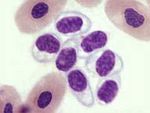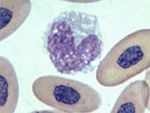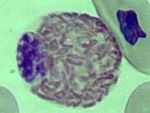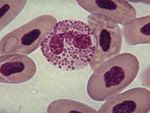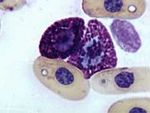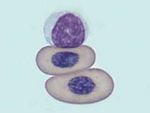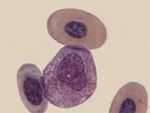Difference between revisions of "Lizard and Snake Haematology"
| (23 intermediate revisions by 5 users not shown) | |||
| Line 1: | Line 1: | ||
| − | {{ | + | {{unfinished}} |
| + | [[Image:Thrombocyte.jpg|150px|thumb|right|'''Thrombocytes''' (Copyright © RVC. All rights reserved)]] | ||
| + | [[Image:Monocyte.jpg|150px|thumb|right|'''Monocyte''' (Copyright © RVC. All rights reserved)]] | ||
| + | [[Image:Heterophil.jpg|150px|thumb|right|'''Heterophil''' (Copyright © RVC. All rights reserved)]] | ||
| + | [[Image:Lizard_eosinophil.jpg|150px|thumb|right|'''Eosinophil''' (Copyright © RVC. All rights reserved)]] | ||
| + | [[Image:Basophil.jpg|150px|thumb|right|'''Basophil''' (Copyright © RVC. All rights reserved)]] | ||
| + | [[Image:Lymphocytes.jpg|150px|thumb|right|'''Lymphocytes''' (Copyright © RVC. All rights reserved)]] | ||
| + | [[Image:Azurophil.jpg|150px|thumb|right|'''Azurophil''' (Copyright © RVC. All rights reserved)]] | ||
Blood (plasma and cells) is approximately 6% of the body weight of snakes and the normal PCV of a snake is about 0.20 to 0.30 l/l (20-30%). Blood cells form in the bone marrow and spleen, and early in life, the liver. | Blood (plasma and cells) is approximately 6% of the body weight of snakes and the normal PCV of a snake is about 0.20 to 0.30 l/l (20-30%). Blood cells form in the bone marrow and spleen, and early in life, the liver. | ||
==Identification== | ==Identification== | ||
Identification of blood cells can be a problem due to lack of comprehensive reference material for reptile haematology, lack of standardised nomenclature for leucocytes, species variation, inappropriate anticoagulants, improper sampling technique and lymph dilution. Automated counting techniques may not be suitable for reptile blood samples because of the nucleated red blood cells. Reptile leucocytes are fragile and the proper technique in preparation of blood smears is important to obtain valid differentials. | Identification of blood cells can be a problem due to lack of comprehensive reference material for reptile haematology, lack of standardised nomenclature for leucocytes, species variation, inappropriate anticoagulants, improper sampling technique and lymph dilution. Automated counting techniques may not be suitable for reptile blood samples because of the nucleated red blood cells. Reptile leucocytes are fragile and the proper technique in preparation of blood smears is important to obtain valid differentials. | ||
| − | Blood cells include erythrocytes which are nucleated, | + | Blood cells include erythrocytes which are nucleated, leucocytes (heterophils, eosinophils, basophils, lymphocytes, monocytes and azurophils) and thrombocytes: |
| − | == | + | ===Thrombocytes=== |
| − | + | ||
| − | == | + | Thrombocytes are ellipsoidal to fusiform shaped with an elliptical, centrally positioned nucleus. They behave similarly to mammalian platelets and are involved in thrombus formation, blood clotting and wound healing. |
| − | + | ||
| + | ===Monocytes=== | ||
| + | |||
| + | Monocytes are generally the largest leucocyte and have a nucleus that is ovoid and indented (often bean shaped). The cytoplasm usually stain blue-gray and often is vacuolated. The monocytes range is generally between 0 and 10% of the differential and may increase in chronic infections. | ||
| + | |||
| + | ===Heterophils=== | ||
| + | |||
| + | Heterophils are large cells with a round to lobed nucleus and fusiform acidophilic cytoplasmic granules. The size varies between species and often varies in individual blood smears. The primary function of heterophils may be phagocytosis. In some species heterophils are the most common leucocyte. | ||
| + | |||
| + | ===Eosinophils=== | ||
| + | |||
| + | Eosinophils are large granulocytes with spherical, acidophilic, cytoplasmic granules that stain blue with Romanowsky's stains in iguanas. The number of eosinophils in the leucocyte differential is variable. | ||
| − | + | ===Basophils=== | |
| − | |||
| − | + | Basophils are small spherical granulocytes with deep-staining basophilic granules. The nonlobed nucleus is slightly eccentric. The number of basophils in a differential leucocyte count is variable and species dependent. | |
| − | |||
| + | ===Lymphocytes=== | ||
| − | + | Lymphocytes are mononuclear cells with scant pale blue cytoplasm. In some species lymphocytes are the most common leucocyte and may represent over 80% of the differential in some reptiles. In reptiles there may be more diversity than just T and B cells. | |
| − | + | ===Azurophil=== | |
| + | Azurophils are leucocytes with an azurophilic appearance. There is debate over their nature. They increase in numbers following antigenic challenge and with infectious diseases. | ||
| + | ==Interpretation== | ||
| + | Blood parameters in reptiles are influenced by a wide array of variables that include species, age, sex, nutritional status, physiological status, season, environment, blood sampling technique, sample handling, use of anticoagulants and methods of staining. It is also not uncommon for blood samples to be contaminated with lymph. Therefore it is preferable to obtain a set of normal reference values for each individual reptile during times of health under known environmental and nutritional conditions. The morphology of cells may provide more information than the cell counts. | ||
| + | ==Staining== | ||
| + | Romanowsky stains, although time consuming, give the best results. DiffQuik may give adequate results. Reticulocytes are detected with new methylene blue, brilliant cresyl blue and other supravital stains. Cell-specific stains are available. | ||
[[Category:Lizard_Diagnostics|H]] | [[Category:Lizard_Diagnostics|H]] | ||
| − | |||
Revision as of 17:24, 20 March 2010
| This article is still under construction. |
Blood (plasma and cells) is approximately 6% of the body weight of snakes and the normal PCV of a snake is about 0.20 to 0.30 l/l (20-30%). Blood cells form in the bone marrow and spleen, and early in life, the liver.
Identification
Identification of blood cells can be a problem due to lack of comprehensive reference material for reptile haematology, lack of standardised nomenclature for leucocytes, species variation, inappropriate anticoagulants, improper sampling technique and lymph dilution. Automated counting techniques may not be suitable for reptile blood samples because of the nucleated red blood cells. Reptile leucocytes are fragile and the proper technique in preparation of blood smears is important to obtain valid differentials.
Blood cells include erythrocytes which are nucleated, leucocytes (heterophils, eosinophils, basophils, lymphocytes, monocytes and azurophils) and thrombocytes:
Thrombocytes
Thrombocytes are ellipsoidal to fusiform shaped with an elliptical, centrally positioned nucleus. They behave similarly to mammalian platelets and are involved in thrombus formation, blood clotting and wound healing.
Monocytes
Monocytes are generally the largest leucocyte and have a nucleus that is ovoid and indented (often bean shaped). The cytoplasm usually stain blue-gray and often is vacuolated. The monocytes range is generally between 0 and 10% of the differential and may increase in chronic infections.
Heterophils
Heterophils are large cells with a round to lobed nucleus and fusiform acidophilic cytoplasmic granules. The size varies between species and often varies in individual blood smears. The primary function of heterophils may be phagocytosis. In some species heterophils are the most common leucocyte.
Eosinophils
Eosinophils are large granulocytes with spherical, acidophilic, cytoplasmic granules that stain blue with Romanowsky's stains in iguanas. The number of eosinophils in the leucocyte differential is variable.
Basophils
Basophils are small spherical granulocytes with deep-staining basophilic granules. The nonlobed nucleus is slightly eccentric. The number of basophils in a differential leucocyte count is variable and species dependent.
Lymphocytes
Lymphocytes are mononuclear cells with scant pale blue cytoplasm. In some species lymphocytes are the most common leucocyte and may represent over 80% of the differential in some reptiles. In reptiles there may be more diversity than just T and B cells.
Azurophil
Azurophils are leucocytes with an azurophilic appearance. There is debate over their nature. They increase in numbers following antigenic challenge and with infectious diseases.
Interpretation
Blood parameters in reptiles are influenced by a wide array of variables that include species, age, sex, nutritional status, physiological status, season, environment, blood sampling technique, sample handling, use of anticoagulants and methods of staining. It is also not uncommon for blood samples to be contaminated with lymph. Therefore it is preferable to obtain a set of normal reference values for each individual reptile during times of health under known environmental and nutritional conditions. The morphology of cells may provide more information than the cell counts.
Staining
Romanowsky stains, although time consuming, give the best results. DiffQuik may give adequate results. Reticulocytes are detected with new methylene blue, brilliant cresyl blue and other supravital stains. Cell-specific stains are available.
